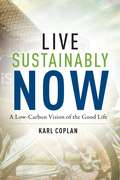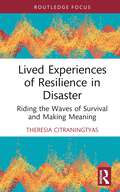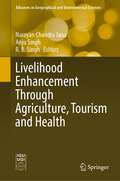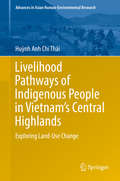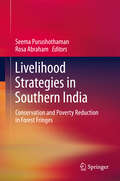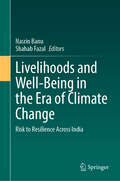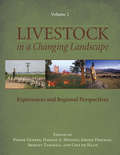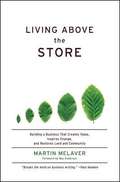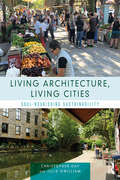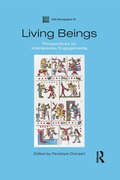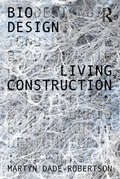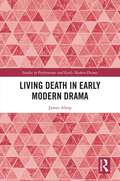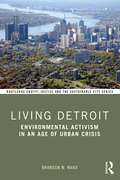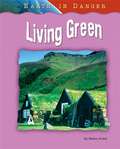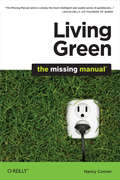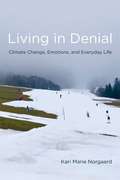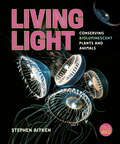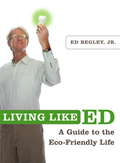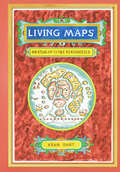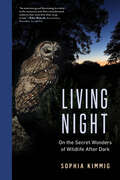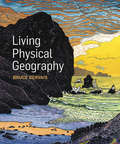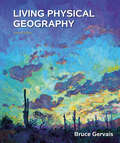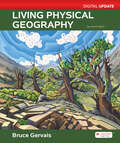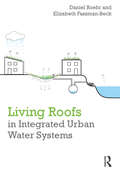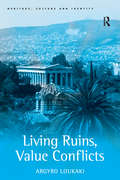- Table View
- List View
Live Sustainably Now: A Low-Carbon Vision of the Good Life
by Karl CoplanAny realistic response to climate change will require reducing carbon emissions to a sustainable level. Yet even people who already recognize that the climate is the most urgent issue facing the planet struggle to understand their individual responsibilities. Is it even possible to live with a sustainable carbon footprint in modern American society—much less to live well? What are the options for those who would like to make climate awareness part of their daily lives but don’t want to go off the grid or become a hermit?In Live Sustainably Now, Karl Coplan shares his personal journey of attempting to cut back on carbon without giving up the amenities of a suburban middle-class lifestyle. Coplan chronicles the joys and challenges of a year on a carbon budget—kayaking to work, hunting down electric-car charging stations, eating a Mediterranean-style diet, and enjoying plenty of travel on weekends and vacations while avoiding long-distance flights. He explains how to set a personal carbon cap and measure your actual footprint, with his own results detailed in monthly diary entries. Presenting the pros and cons of different energy, transportation, and lifestyle options, Live Sustainably Now shows that there does not have to be a trade-off between the ethical obligation to maintain a sustainable carbon footprint and the belief that life should be fulfilling and fun. This powerful and persuasive book provides an individual-level blueprint for a carbon-sustainable tweak to the American dream.
Lived Experiences of Resilience in Disaster: Riding the Waves of Survival and Making Meaning
by Theresia CitraningtyasCapturing new waves of thought on resilience and recovery, Citraningtyas explores how people survive and make meaning in disasters by bringing together survivor experiences from natural disaster events in two vastly different cultural contexts. By presenting a holistic model of conceptualising people’s experiences of dealing with disastrous situations, this book transcends psychiatric approaches of trauma recovery. It uses metaphors to present harrowing and inspiring survivor narratives from the 2004 tsunami in Aceh and the 2003 Canberra bushfires and analyzes the ways in which survivors tried to cope and make sense of their experiences as well as their own lives, in order to cope. Through embodied metaphors to unravel different aspects of meaning‑making following disasters, Citraningtyas provides insights into how culture can shape our experiences and responses to disaster, and brings forth deep commonalities in inherently human experiences.This book will appeal to researchers interested in understanding trauma resilience and recovery as well as mental health practitioners and disaster survivors.
Livelihood Enhancement Through Agriculture, Tourism and Health (Advances in Geographical and Environmental Sciences)
by R. B. Singh Narayan Chandra Jana Anju SinghAgriculture is the backbone of our economic system. It provides not only food and raw material but also employment opportunities to a very large number of people. Higher atmospheric temperature has an impact on crop yields while the changes in rainfall could affect both crop quality and quantity. Climate change, therefore, could increase the prices of major crops in some regions. For the most vulnerable people, lower agricultural output means lower income. In addition, climate change is expected to increase the risk of illness and death from extreme heat and poor air quality. Recent evidence is the COVID-19 pandemic. Furthermore, climate change also affects the occurrence of other infectious diseases. A number of well-known diseases are climate-sensitive - malaria, dengue fever, and cholera among others. Tourism is considered as an industry and alternative contributor to a nation’s income. It can generate employment opportunities and boost up the economy. This book, consisting of 26 chapters, focuses on the issues of agriculture, tourism and health for livelihood enhancement. It is essential to discuss these diverse issues in the field of geography as it encompasses interdisciplinary topics. The range of concerns at the national, regional and local levels is not confined to geography only but also involves other disciplines as well. Therefore, this book is a valuable source for scientists and researchers in allied fields such as livelihood, agriculture, land use, tourism management, health care and tribal studies. Furthermore, this book can be of immense help to the researchers, planners and decision makers engaged in solving problems in these areas in developing countries and beyond.
Livelihood Pathways of Indigenous People in Vietnam’s Central Highlands: Exploring Land-Use Change (Advances in Asian Human-Environmental Research)
by Huỳnh Anh Chi TháiThis study focuses on impacts of the environmental and socio-economic transformation on the indigenous people's livelihoods in Vietnam's Central Highlands recent decades since the country's reunification in 1975.The first empirical section sheds light on multiple external conditions (policy reforms, population trends, and market forces) exposed onto local people. The role of human and social capital is examined again in a specific livelihood of community-based tourism to testify the resilience level of local people when coping with constraints. The study concludes with an outlook on implications of development processed which still places agriculture at the primary position livelihood, and pays attention to human capital and social capital of indigenous groups in these highlands.
Livelihood Strategies in Southern India
by Seema Purushothaman Rosa AbrahamThis volume is a compilation of essays that focus on livelihood issues faced by forest communities of the southern Western Ghats region of India. Communities living along the fringes of forests are, more often than not, overlooked in academic and policy discussions. However, they face considerable pressures, being sandwiched between conservation endeavours and the forces of urbanization and commercialization. The chapters in this book provide an insight into the kinds of livelihood issues these communities face and the potential means that can be adopted to sustain these livelihoods. This volume provides a unique alternative perspective by locating livelihood issues within socio-ecological-economic narratives of communities living at the intersection of the three southern Indian states of Karnataka, Kerala and Tamil Nadu, and suggests directions for policies to address these challenges.
Livelihoods and Well-Being in the Era of Climate Change: Risk to Resilience Across India
by Shahab Fazal Nasrin BanuThis volume addresses livelihood vulnerabilities due to climate change-induced socio-environmental stresses among different communities in various geographical locations in India, and discusses how the people and communities can become resilient to these stresses. Through multiple case studies and regional analyses, the authors provide a holistic understanding of the impacts of climate change on livelihoods and well-beings in India, where other works on the subject are often fragmentary and do not encompass a comprehensive presentation of these topics. This dedicated volume offers this comprehensive coverage, exploring how climate change impacts vulnerable communities, and how different actors such as vulnerable people, communities, governments, and NGOs are adopting strategies for resilience and sustainable livelihoods. As the impacts of climate change vary over geographical regions, the book targets a systematic coverage of the issue for different geographical regions in South Asia/ India, including the Himalayan region (Hilly Area), Indo-Gangetic Plain, Sundarbans (Mangroves), Coastal lands, Deccan Plateau, and Western Semi-arid and arid areas. The book is intended for social and environmental scientists, geographers, anthropologists, sociologists, regional planners, public administrators, and policymakers.
Livestock in a Changing Landscape, Volume 2: Experiences and Regional Perspectives
by Harold A. Mooney Jeroen Dijkman Pierre Gerber Shirley Tarawali Cees De HaanThe rapidly changing nature of animal production systems, especially increasing intensification and globalization, is playing out in complex ways around the world. Over the last century, livestock keeping evolved from a means of harnessing marginal resources to produce items for local consumption to a key component of global food chains. Livestock in a Changing Landscape offers a comprehensive examination of these important and far-reaching trends. The books are an outgrowth of a collaborative effort involving international nongovernmental organizations including the United Nations Food and Agriculture Organization (UN FAO), the International Livestock Research Institute (ILRI), the Swiss College of Agriculture (SHL), the French Agricultural Research Centre for International Development (CIRAD), and the Scientific Committee for Problems of the Environment (SCOPE). Volume 1 examines the forces shaping change in livestock production and management; the resulting impacts on landscapes, land use, and social systems; and potential policy and management responses. Volume 2 explores needs and draws experience from region-specific contexts and detailed case studies. The case studies describe how drivers and consequences of change play out in specific geographical areas, and how public and private responses are shaped and implemented. Together, the volumes present new, sustainable approaches to the challenges created by fundamental shifts in livestock management and production, and represent an essential resource for policy makers, industry managers, and academics involved with this issue
Living Above the Store
by Martin MelaverThe economic crash of late 2008 is just the latest evidence of the truth that many have known: that too much of our modern economy is based on a house of cards. We need businesses that not only factor their impact on people and places into their equations for success but also strive to restore the communities and environments in which they operate. Martin Melaver provides a roadmap for creating such a business. It's not only a "how to" but a "why to" that challenges business as usual to change. "Living Above the Store" brings us into the story of Melaver, Inc. , a third-generation, 70-year-old family real estate business, as it evolves toward becoming a thought and product leader in sustainable business practices. It is part business management theory and part case study, where sustainable principles meet sustainable practices, always grounded in day-to-day practice. "Living Above the Store" demonstrates how to: adopt a business model that provides for economic success while contributing to society and the environment; shape a business culture that is restorative to a workforce by helping employees realize their highest potential; leverage an ethos within a business that "ripples outward" to foster restoration of both land and community; embrace a notion of limits to growth; and reframe ideas about competition, proprietary knowledge, and business success "Living Above the Store" is for readers who care about issues of community and sustainability.
Living Architecture, Living Cities: Soul-Nourishing Sustainability
by Christopher Day Julie GwilliamIt’s widely accepted that our environment is in crisis. Less widely recognized is that three quarters of environmental damage is due to cities – the places where most of us live. As this powerful new book elucidates, global sustainability is therefore directly dependent on urban design. In Living Architecture, Living Cities Christopher Day and Julie Gwilliam move beyond the current emphasis on technological change. They argue that eco-technology allows us to continue broadly as before and only defers the impending disaster. In reality, most negative environmental impacts are due to how we live and the things we buy. Such personal choices often result from dissatisfaction with our surroundings. As perceived environment has a direct effect on attitudes and motivations, improving this can achieve more sustainable lifestyles more effectively than drastic building change – with its notorious performance-gap limitations. As it’s in places that our inner feelings and material reality interact, perceived environment is place-based. Ultimately, however, as the root cause of unsustainability is attitude, real change requires moving from the current focus on buildings and technology to an emphasis on the non-material. Featuring over 400 high quality illustrations, this is essential reading for anyone who believes in the value and power of good design. Christopher Day’s philosophy will continue to inspire students with an interest in sustainable architecture, urban planning and related fields.
Living Beings: Perspectives on Interspecies Engagements (ASA Monographs)
by Penelope DransartLiving Beings examines the vital characteristics of social interactions between living beings, including humans, other animals and trees.Many discussions of such relationships highlight the exceptional qualities of the human members of the category, insisting for instance on their religious beliefs or creativity. In contrast, the international case studies in this volume dissect views based on hierarchical oppositions between human and other living beings. Although human practices may sometimes appear to exist in a realm beyond nature, they are nevertheless subject to the pull of natural forces. These forces may be brought into prominence through a consideration of the interactions between human beings and other inhabitants of the natural world.The interplay in this book between social anthropologists, philosophers and artists cuts across species divisions to examine the experiential dimensions of interspecies engagements. In ethnographically and/or historically contextualized chapters, contributors examine the juxtaposition of human and other living beings in the light of themes such as wildlife safaris, violence, difference, mimicry, simulation, spiritual renewal, dress and language.
Living Construction (Bio Design)
by Martyn Dade-RobertsonModern biotechnologies give us unprecedented control of the fundamental building blocks of life. For designers, across a range of disciplines, emerging fields such as synthetic biology offer the promise of new sustainable materials and structures which may be grown, are self-assembling, are self-healing and adaptable to change. While there is a thriving speculative discourse on the future of design in the age of biotechnology, there are few realized design applications. This book, the first in the Bio Design series, acts as a bridge between design speculation and scientific reality and between contemporary design thinking, in areas such as architecture, product design and fashion design, and the traditional engineering approaches which currently dominate bio technologies. Filled with real examples, Living Construction reveals how living cells construct and transform materials through methods of fabrication and assembly at multiple scales and how designers can utilize these processes.
Living Death in Early Modern Drama (ISSN)
by James AlsopThis book explores historical, socio-political, and metatheatrical readings of a whole host of dying bodies and risen corpses, each part of a long tradition of living death on stage.Just as zombies, ghouls, and the undead in modern media often stand in for present-day concerns, early modern writers frequently imagined living death in complex ways that allowed them to address contemporary anxieties. These include fresh bleeding bodies (and body parts), ghostly Lord Mayors, and dying characters who must carefully choose their last words – or have those words chosen for them by the living. As well as offering fresh interpretations of well-known plays such as Middleton’s The Lady’s Tragedy and Webster’s The White Devil, this innovative study also sheds light on less well-known works such as the anonymous The Tragedy of Locrine, Marston’s Antonio’s Revenge, and Munday’s mayoral pageants Chruso-thriambos and Chrysanaleia. The author demonstrates that wherever characters in early modern drama appear to straddle the line between this world and the next, it is rarely a simple matter of life and death.This book will be of great interest to students, scholars, and practitioners in theatre and performance studies, and cultural and social studies.
Living Detroit: Environmental Activism in an Age of Urban Crisis (Routledge Equity, Justice and the Sustainable City series)
by Brandon M. WardIn Living Detroit, Brandon M. Ward argues that environmentalism in postwar Detroit responded to anxieties over the urban crisis, deindustrialization, and the fate of the city. Tying the diverse stories of environmental activism and politics together is the shared assumption environmental activism could improve their quality of life. Detroit, Michigan, was once the capital of industrial prosperity and the beacon of the American Dream. It has since endured decades of deindustrialization, population loss, and physical decay – in short, it has become the poster child for the urban crisis. This is not a place in which one would expect to discover a history of vibrant expressions of environmentalism; however, in the post-World War II era, while suburban, middle-class homeowners organized into a potent force to protect the natural settings of their communities, in the working-class industrial cities and in the inner city, Detroiters were equally driven by the impulse to conserve their neighborhoods and create a more livable city, pushing back against the forces of deindustrialization and urban crisis. Living Detroit juxtaposes two vibrant and growing fields of American history which often talk past each other: environmentalism and the urban crisis. By putting the two subjects into conversation, we gain a richer understanding of the development of environmental activism and politics after World War II and its relationship to the crisis of America’s cities. This book will be of great interest to students and scholars in environmental, urban, and labor history.
Living Green (Earth in Danger)
by Helen OrmeFrom hybrid cars to energy-efficient light bulbs, the green movement has generated interest in lifestyle changes that help preserve and protect the environment. Living Green pairs easy-to-read text with vibrant photos to engage kids as they explore ways to maintain our natural resources for future generations. A section in the back of the book will inspire young environmentalists by suggesting ways they can help protect their planet.
Living Green: The Missing Manual (Missing Manual)
by Nancy ConnerTaking care of the earth is more important than ever, but the problems we're facing can seem overwhelming. Living Green: The Missing Manual helps make earth-friendly decisions more manageable by narrowing them down to a few simple choices. This all-in-one resource is packed with practical advice on ways you can help the environment by making simple changes in your home routine, work habits, and the way you shop and get around town. You don't have to embark on a radical new lifestyle to make a difference. Living Green: The Missing Manual shows you how small changes can have a big impact. With this book, you will:Learn how to make your home energy efficient and free of toxic chemicalsDiscover how to reduce waste, repurpose and recycle, and do more with lessBuild and remodel earth-friendly homes with new techniques and materialsLearn tips for buying organic food and what it takes to grow your ownGet helpful information on fuel-efficient cars, including hybrid and electric modelsMake your workplace greener and more cost-effective -- from changes at your desk to suggestions for company-wide policiesExplore how to choose renewable energies, such as wind and solar powerThe book also provides you with ways to connect with like-minded people and offers a survey of exciting new green technologies. Learn how you can help the planet with Living Green: The Missing Manual.
Living In Denial: Climate Change, Emotions, and Everyday Life
by Kari Marie NorgaardGlobal warming is the most significant environmental issue of our time, yet public response in Western nations has been meager. Why have so few taken any action? In Living in Denial,sociologist Kari Norgaard searches for answers to this question, drawing on interviews and ethnographic data from her study of "Bygdaby," the fictional name of an actual rural community in western Norway, during the unusually warm winter of 2000-2001. In 2000-2001 the first snowfall came to Bygdaby two months later than usual; ice fishing was impossible; and the skiindustry had to invest substantially in artificial snow-making. Stories in local and national newspapers linked the warm winter explicitly to global warming. Yet residents did not write letters to the editor, pressure politicians, or cut down on use of fossil fuels. Norgaard attributes this lack of response to the phenomenon of socially organized denial, by which information about climate science is known in the abstract but disconnected from political, social, and private life, and sees this as emblematic of how citizens of industrialized countries are responding to global warming. Norgaard finds that for the highly educated and politically savvy residents of Bygdaby, global warming was both common knowledge and unimaginable. Norgaard traces this denial through multiple levels, from emotions to cultural norms to political economy. Herreport from Bygdaby, supplemented by comparisons throughout the book to the United States, tells alarger story behind our paralysis in the face of today's alarming predictions from climate scientists. The hardcover edition does not include a dust jacket.
Living Light: Conserving Bioluminescent Plants and Animals (Orca Wild #14)
by Stephen AitkenBioluminescent animals make their own light to survive. A firefly lights up the night sky, a foxfire mushroom sets the forest floor aglow and sea butterflies shine like beacons deep in the ocean. These glowing species are one of the most spectacular wonders of the natural world, and they are found on land, in the air and in the depths of the ocean. In Living Light, discover how and why bioluminescent creatures glow, and what that special ability can tell scientists about how diseases such as cancer and malaria spread in humans. These light makers are facing threats from the effects of climate change, pollution and loss of habitat, and they need our protection. Young readers will learn how they can shine a light on bioluminescent species and use citizen science to conserve their habitats and keep these creatures glowing into the future. The epub edition of this title is fully accessible.
Living Like Ed: A Guide to the Eco-friendly Life
by Ed Begley Jr.FROM THE PIONEER OF ECO-CONSCIOUS LIVING. A committed environmentalist for more than thirty years, Ed Begley, Jr., has always tried to "live simply so others may simply live." Now, as more and more of us are looking for ways to reduce our impact on the planet and live a better, greener life, Ed shares his experiences on what works, what doesn't--and what will save you money! These are tips for environmentally friendly living that anyone-whether you own or rent, live in a private home or a condo-can try to make a positive change for the environment. From quick fixes to bigger commitments and long-term strategies, Ed will help you make changes in every part of your life. And if you think living green has to mean compromising on aesthetics or comfort, fear not; Ed's wife, Rachelle, insists on style-with a conscience. In Living Like Ed, his environmentalism and her design savvy combine to create a guide to going green that keeps the chic in eco-chic. From recycling more materials than you ever thought possible to composting without raising a stink to buying an electric car, Living Like Ed is packed with ideas-from obvious to ingenious-that will help you live green, live responsibly, live well. Like Ed.
Living Maps: An Atlas of Cities Personified
by Adam DantVenture to twenty-eight cities around the world in this colorfully illustrated collection of maps that take you on a journey through history, culture, and geography.On each page, you’ll visit a different city. And in each city, you’ll explore the metaphorical resonance between the physical metropolis and its inhabitants, history, and culture. In the hands of a creative cartographer, Manhattan is dissected in an anatomical diagram, the streets of Monaco trace the form of a Picasso nude, and the crisscrossing paths of boats on the Bosphorus become the nerves of Istanbul.Travel as you never have traveled before, and revel in the details that define urban life. By laying bare the bone, muscle, and sinew of twenty-eight cities, these maps reveal the unique spirit of each one and shed light on the strange and marvelous ways in which humans interact with the places they call home.Witty and insightful, this book will capture the imaginations of travelers, map enthusiasts, history buffs, and dreamers.
Living Night: On the Secret Wonders of Wildlife After Dark
by Sophia KimmigNatural darkness isn’t merely a time of day. For countless extraordinary species, it’s home. “An entertaining and illuminating love letter to the mysterious and often misunderstood creatures that come alive when we go to bed—and a call to preserve our precious, shared world.”—Robin Bicknell, award-winning documentary filmmaker, Ice and Fire and Nature’s Cleanup Crew When the sun sets, things start to get interesting among wild animals. Wherever we live, whether in the city or suburbs or country, darkness conjures a hidden world of wildlife that most of us rarely glimpse. Foxes, wolves, and bears prowl while skunks, opossums, and porcupines lurk; fireflies send flashing signals to potential mates; raccoons rummage for food; owls and bats fly overhead. Wildlife biologist Sophia Kimmig is our guide to the startling behaviors of these and many more nocturnal creatures. Introducing us to night’s wild inhabitants, she reveals what life for them is like in this parallel world—how it looks, feels, and smells—and the ingenious ways some creatures thrive after sunset. Living Nighthelps us appreciate how essential darkness is: not just a time but a diverse habitat all to itself—one that we still know too little about, and that we must urgently protect for the benefit of the world’s flora and fauna that depend on the day–night cycle.
Living Physical Geography
by Bruce GervaisBruce Gervais' new text offers a fresh approach to the study of physical geography, combining print and digital media to create a scientifically substantive work that is written for students. Living Physical Geography focuses on human-physical geography interactions, using pedagogical features in the textbook and online to create a modern synthesis of the science of physical geography. Each of the four major parts in Living Physical Geography is identified by energy flows within Earth's physical systems. Additionally, landscape analysis underpins the body of the text. Step-by-step examples are used to illustrate how landforms and systems develop, evolve, and change through time. Living Physical Geography is accompanied by its own dedicated version of W. H. Freeman's breakthrough online course space, LaunchPad. LaunchPad offers acclaimed media content, curated and organized for easy assignability and presented in an intuitive interface that combines power and simplicity. What's in the LaunchPad
Living Physical Geography
by Bruce GervaisThe second edition of Bruce Gervais’ Living Physical Geography offers a fresh approach to the study of physical geography, combining print and digital media to create a scientifically substantive work that is written for students. Living Physical Geography focuses on human-physical geography interactions, using pedagogical features in the textbook and online in SaplingPlus to create a modern synthesis of the science of physical geography. In this, the most student-friendly book in the market, the authors Bruce Gervais has curated and designed all of the learning assets within the text and online in SaplingPlus. Each of the four major parts in Living Physical Geography focuses on energy flows within Earth’s physical systems. Additionally, landscape analysis underpins the body of the text. Step-by-step examples are used to illustrate how landforms and systems develop, evolve, and change through time.
Living Physical Geography Digital Update
by Bruce GervaisLiving Physical Geography 2e Digital Update helps you understand how people change and are changed by Earth’s physical systems, ranging from local stream erosion to global climate change.
Living Roofs in Integrated Urban Water Systems
by Daniel Roehr Elizabeth Fassman-BeckWith the infrastructure to manage storm water threats in cities becoming increasingly expensive to build or repair, the design community needs to look at alternative approaches. Living roofs present an opportunity to compliment ground-level storm water control measures, contributing to a holistic, integrated urban water management system. This book offers tools to plan and design living roofs, in the context of effectively mitigating storm water. Quantitative tools for engineering calculations and qualitative discussion of potential influences and interactions of the design team and assembly elements are addressed.
Living Ruins, Value Conflicts (Heritage, Culture and Identity)
by Argyro LoukakiUsing monuments and ruins by way of illustration, this fascinating book examines the symbolic, ideological, geographical and aesthetic importance of Greek classical iconography for the Western world. It examines how classical Greek monuments are simultaneously perceived as sublime national symbols and as a mythological and archetypal reference against which Western modernism is measured. The book investigates the dialogue this double identity leads to, as well as frequent clashes between ancient (but also later) monuments and their modern urban or regional environment. Living Ruins, Value Conflicts examines the complex historical process of monument restoration and enhancement, and analyses the nexus of changing perceptions, aesthetic visions and formal principles over the past two centuries. The book shows the ways in which archaeology and monumentality affect modern life, the modern aesthetic, our notions of nationhood, of place, of self - and the limits to and possibilities for national development imposed by the need to ensure ruins are kept 'alive'.
